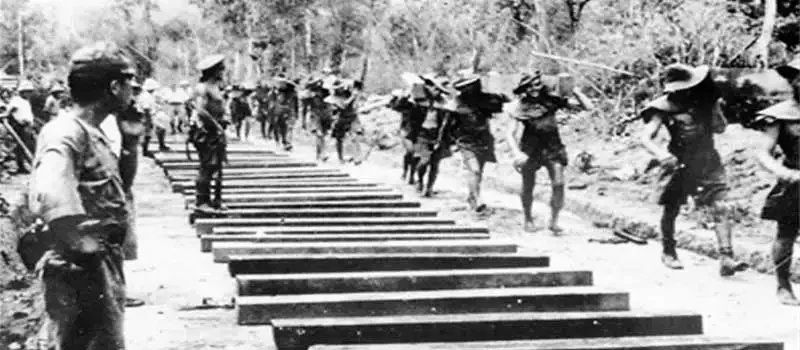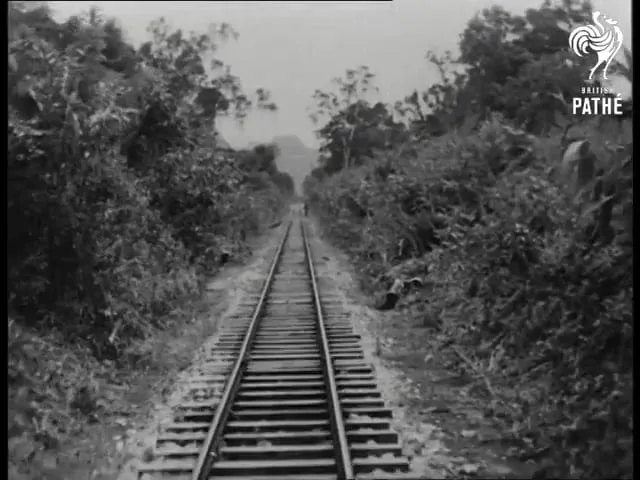- Military History
- Prisons, Prisoners & Camps
- Events
- Burma-Thailand Death Railroad (1942)

Burma-Thailand Death Railroad (1942) Railroad build between 1942 and 1943 by POW’s and native slave labor under the worst possible conditions
Built between 1942 and 1945 by Allied prisoners of war and native slave labor, and extending from Ban Pong, Thailand, to Thanbyuzayat, Burma, the Burma-Thailand railway was intended to supply Japanese forces fighting in Burma. As World War II progressed, American submarines and Allied aircraft had increasingly threatened Japanese cargo ships in the Indian Ocean.
Japanese military planners assumed that an all-land route from Bangkok to northern Burma would improve the chances of supplies reaching the front. Accordingly, a railway was planned to link two existing lines. One that ran west from Bangkok to Ban Pong in Thailand and then south along the Gulf of Siam to Singapore, and another that ran entirely in Burma from Ye, on the Andaman coast, north to Thanbyuzayat and then to Rangoon (Yangon). When completed, the new road was 261 miles (421 km) long and followed the Mae Klong and Kwae Noi Rivers across some of the most inhospitable terrain in the world with dense jungle, rugged mountains, swift streams, and monsoon-flooded plains.
Time would demonstrate that the Japanese had been wrong in pinning such hopes on the new railway. Allied bombers began interrupting traffic even before it was completed and continued their devastation until the Japanese abandoned the line in early 1945.
The Japanese regarded POW’s as an ideal work force for the project. They had captured many more than expected and did not want to feed what they considered to be a useless rabble. As a consequence, the railway became the largest single use of POW’s by the Japanese in World War II; among the approximately 61,000 Allied prisoners who worked on it were 13,000 Australians and New Zealanders, 30,000 British and British colonials, 18,000 Dutch and Indonesian-Dutch, and 668 Americans.
The conditions under which they labored were unbelievably cruel. Many of the guards were Koreans pressed into duty, and most of the supervisors were the incompetents and misfits of the imperial army. One Scottish POW, Ernest Gordon, who for years after his ordeal was dean of the chapel at Princeton University, described conditions clearly:
"The Japanese military violated every civilized code. They murdered prisoners overtly by bayoneting, shooting, drowning, or decapitation; they murdered them covertly by working them beyond human endurance, starving them, torturing them, and denying them medical care".
Men suffered malnutrition, dysentery, beriberi, jungle ulcers, malaria, and many other maladies, and more than 12,000 of the POW’s died or were killed during construction, a death rate of one in five or about 55 POW’s per mile. The estimated death rate by nationality was one in three Britons, one in four Anzacs (Australian and New Zealand Army Corps), one in five Americans, and one in six Dutch and Indonesians. Although figures are hard to ascertain, perhaps 250,000 native conscripts worked on the railway and 125,000 of them perished. It has been written that one worker died for every sleeper (cross-tie) laid.
After the road was finished, the Japanese erected a pyramidal, 25-foot (7.6 m) monument as a memorial, a structure that one American POW called "the greatest travesty of all. It denied, the very date it was dedicated, all the freedoms, liberties, and human dignity that men should accord one another".
The line was closed completely in 1947, but the section between Nong Pla Duk and Nam Tok was reopened ten years later.
Another memorial was the 1957 Oscar-winning movie The Bridge on the River Kwai, which, although unable to project the suffering and cruelty adequately, remains an extremely effective reminder of the building of the Death Railway.
- WWII (1939-1945)
- Pacific War (1941-1945)
- {{#owner}}
- {{#url}} {{#avatarSrc}}
{{name}} {{/url}} {{^url}} {{#avatar}} {{& avatar}} {{/avatar}} {{name}} {{/url}} - {{/owner}} {{#created}}
- {{created}} {{/created}}

























